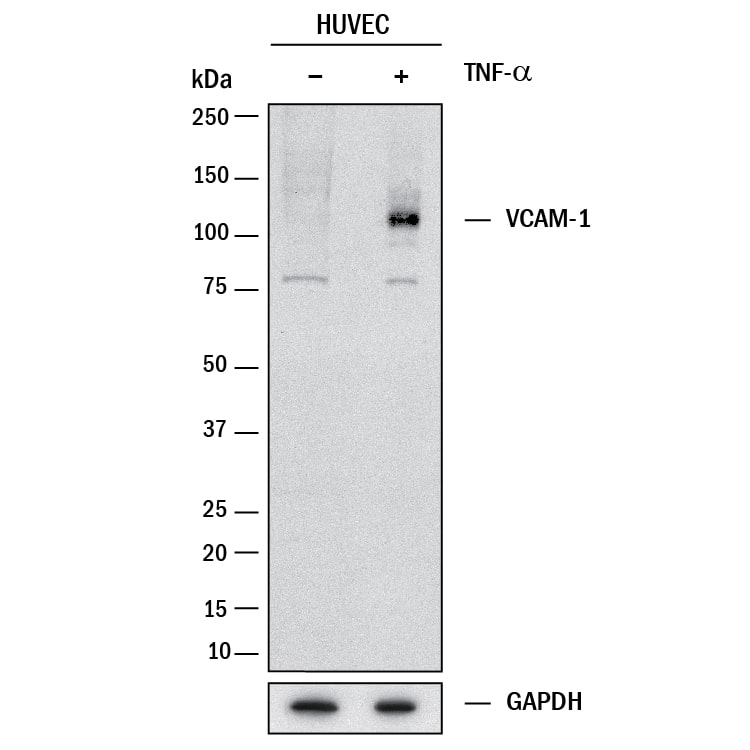Human VCAM-1/CD106 Antibody
R&D Systems, part of Bio-Techne | Catalog # MAB8092
Recombinant Monoclonal Antibody.


Conjugate
Catalog #
Key Product Details
Species Reactivity
Human
Applications
Flow Cytometry, Western Blot
Label
Unconjugated
Antibody Source
Recombinant Monoclonal Rabbit IgG Clone # 2691A
Product Specifications
Immunogen
Chinese Hamster Ovary cell line CHO-derived human VCAM-1/CD106
Phe25-Glu698
Accession # P19320-1
Phe25-Glu698
Accession # P19320-1
Specificity
Detects human VCAM-1/CD106 in direct ELISAs.
Clonality
Monoclonal
Host
Rabbit
Isotype
IgG
Scientific Data Images for Human VCAM-1/CD106 Antibody
Detection of Human VCAM-1/CD106 by Western Blot.
Western blot shows lysates of HUVEC human umbilical vein endothelial cells untreated (-) or treated (+) with 10 ng/mL Recombinant Human TNF-alpha (210-TA) for 24 hours. PVDF membrane was probed with 4 µg/mL of Rabbit Anti-Human VCAM-1/CD106 Monoclonal Antibody (Catalog # MAB8092) followed by HRP-conjugated Anti-Rabbit IgG Secondary Antibody (HAF008). A specific band was detected for VCAM-1/CD106 at approximately 110 kDa (as indicated). GAPDH (MAB5718) is shown as a loading control. This experiment was conducted under reducing conditions and using Western Blot Buffer Group 1.Detection of VCAM-1/CD106 in Hut78 Human Cell Line by Flow Cytometry.
Hut78 human cutaneous T cell lymphoma cell line was stained with Rabbit Anti-Human VCAM-1/CD106 Monoclonal Antibody (Catalog # MAB8092, filled histogram) or isotype control antibody (MAB1050, open histogram), followed by Phycoerythrin-conjugated Anti-Rabbit IgG Secondary Antibody (F0110). Staining was performed using our Staining Membrane-associated Proteins protocol.Applications for Human VCAM-1/CD106 Antibody
Application
Recommended Usage
Flow Cytometry
0.25 µg/106 cells
Sample: Hut78 human cutaneous T cell lymphoma cell line
Sample: Hut78 human cutaneous T cell lymphoma cell line
Western Blot
4 µg/mL
Sample: HUVEC human umbilical vein endothelial cells treated Recombinant Human TNF‑ alpha (Catalog # 210-TA)
Sample: HUVEC human umbilical vein endothelial cells treated Recombinant Human TNF‑ alpha (Catalog # 210-TA)
Formulation, Preparation, and Storage
Purification
Protein A or G purified from cell culture supernatant
Reconstitution
Reconstitute at 0.5 mg/mL in sterile PBS. For liquid material, refer to CoA for concentration.
Formulation
Lyophilized from a 0.2 μm filtered solution in PBS with Trehalose. *Small pack size (SP) is supplied as a 0.2 µm filtered solution in PBS.
Shipping
Lyophilized product is shipped at ambient temperature. Liquid small pack size (-SP) is shipped with polar packs. Upon receipt, store immediately at the temperature recommended below.
Stability & Storage
Use a manual defrost freezer and avoid repeated freeze-thaw cycles.
- 12 months from date of receipt, -20 to -70 °C as supplied.
- 1 month, 2 to 8 °C under sterile conditions after reconstitution.
- 6 months, -20 to -70 °C under sterile conditions after reconstitution.
Background: VCAM-1/CD106
References
- Vonderheide, R.H. et al. (1994) J. Cell Biol. 125:215.
- Cybulsky, M.I. et al. (1991) Proc. Natl. Acad. Sci. USA 88:7859.
- Luster, A.D. et al. (2005) Nat. Immunol. 6:1182.
- Osborn, L. et al. (1989) Cell 59:1203
- Langer. H.F. et al. 2009. J Cell Mol Med. 13:1211.
- Willeit.K. et al. 2017. JAMA Cardiol. 2:516.
- Lo Iacono.O. et al. 2008. Liver Int. 28:1129.
- Wu.T.C. et al. 2007. Cancer Research. 67:6003
Long Name
Vascular Cell Adhesion Molecule 1
Alternate Names
CD106, VCAM1
Gene Symbol
VCAM1
UniProt
Additional VCAM-1/CD106 Products
Product Documents for Human VCAM-1/CD106 Antibody
Product Specific Notices for Human VCAM-1/CD106 Antibody
For research use only
